Sphinx › Hermes » Ancient origins
Articles and Definitions › Contents
- Sphinx › Antique Origins
- Hermes › Who Was
Ancient civilizations › Historical and archaeological sites
Sphinx › Antique Origins
Definition and Origins
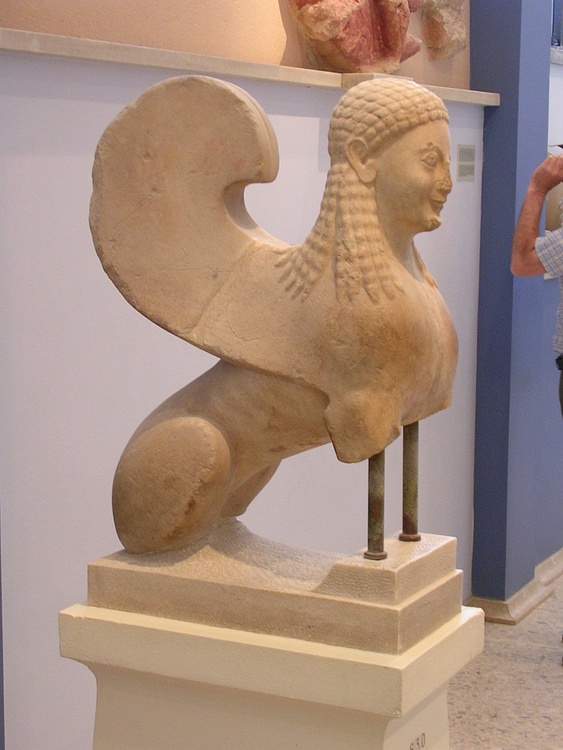
A sphinx is a mythical creature with the body of a lion, most often with a human head and sometimes with wings. The creature was an Egyptian invention and had a male head - human or animal; however, in ancient Greek culture the creature had the head of a woman. The sphinx is also present in the art and sculpture of the Mycenaean, Assyrian, Persian and Phoenician civilizations.
Sphinxes were first created by the Egyptians and usually wore a nemes (head-dress) as worn by Pharaohs. Examples exist of sphinxes with human faces but surrounded by a lion's mane, particularly from Nubia, and in the New Kingdom the head was sometimes that of a ram and representative of Amun. The exact date when the first sphinx appeared is not known and the most famous sphinx of all, the Great Sphinx of Giza, has not been precisely dated; some scholars date it as far back as the reign of Cheops, ca 2500 BCE. There is a story that in the Eighteenth Dynasty, Tuthmosis IV, when he was a mere prince, went on a hunting expedition and fell asleep in the shadow of the Sphinx. Whilst asleep he dreamt that the Sphinx spoke to him and promised that he would become king if he cleared the sands that had accumulated around the feet of the statue. In the reign of Chephren, sphinxes became more widespread and they were usually placed as guards outside temples, tombs and funerary monuments.
IN CONTRAST TO THE EGYPTIANS, THE ANCIENT GREEKS SAW THE SPHINX AS A MORE TROUBLESOME CREATURE.
Sphinxes were also present in the art of the Minoan and Mycenaean cultures from the early second millennium BC. The earliest examples are found on clay relief plaques used to decorate pottery vessels and on beaten gold dress ornaments from Minoan Crete. Later, three-dimensional sphinxes were similarly added to clay vessels and a surviving fresco from Pylos also depicted the mythical creature. In the 13th century BCE there are examples of pottery found in Cyprus (but probably manufactured on the Greek mainland) with painted sphinxes in silhouette, often in pairs and positioned heraldically. Sphinxes were also a popular subject for Mycenaean ivory carvings, usually in the form of plaques and small, lidded boxes.
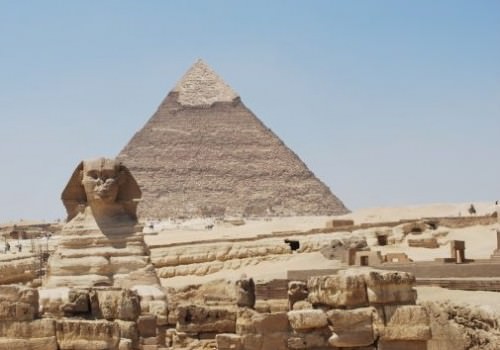
sphinx and khephren pyramid
The sphinx was also commonly represented in both Assyrian and Persian art, usually with wings and a male human head.Large, sculpted sphinxes in the shape of winged bulls often stood in pairs outside palaces and guarded against evil forces.Such an example is the large sphinx presently in the British Museum which once stood outside the palace of Ashurnasirpal IIat Nimrud (ca 865 BCE). Persian architecture often incorporated sphinxes in low-relief in walls and gates, examples from Susa (6th century BCE) and Persepolis (4th century BCE) depict male-headed sphinxes wearing divine horned headdresses.
In contrast to the Egyptian view, the ancient Greeks saw the sphinx as a more troublesome creature and the most famous myth involving a sphinx is that of the Theban prince Oedipus : The territory of Thebes in Greece was terrorized by a sphinx and Hesiod tells us in his Theogony that the creature was born from the Chimaera (a fire-breathing monster with three heads and a body part lion, goat, snake and dragon) and was sister to the Nemean lion and half-sister of Kerberos (the three-headed dog that guarded Hades ). The sphinx created drought and famine and would only leave the Thebans alone if they solved her riddle. This was to define the creature that has two, three or four feet and although it is able to change its form, it moves slower the more feet it uses. Anyone who dared to answer the riddle and failed to do so correctly was killed and devoured by the sphinx. When the sphinx killed his son Haimon, Kreon, the king of Thebes became so desperate at the situation that he offered his kingdom and his daughter Iokaste to anyone who could answer the riddle. Oedipus took up the challenge and gave the correct answer --man-- and in frustration and anger the sphinx leapt to her death from the acropolis of Thebes. Scenes of the hero with the sphinx are the most common depictions in art of the Oedipus myth and appeared from the 6th century BC on pottery, on carved gems and as a decorative device on fabrics.
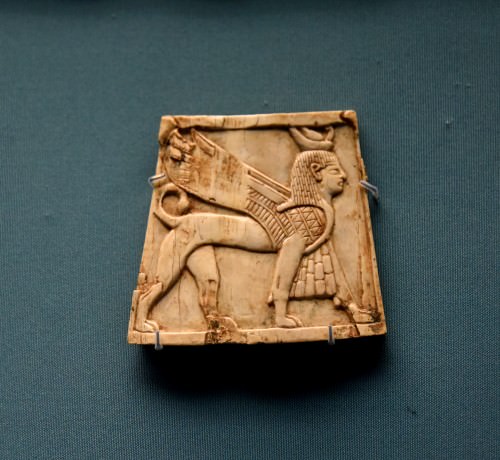
Nimrud Ivory Panel of a Winged Sphinx
In ancient Greek culture, the first sphinxes to appear in sculpture appeared from the 7th century BCE. These were made from clay and are particularly associated with Crete where moulded heads of sphinxes were sometimes added to pithoi. From the 6th century BCE, sphinxes appeared in stone sculpture, sometimes with raised hind quarters. These sculptures were used as votive offerings, usually perched atop tall Ionic or Doric columns and placed at sanctuary sites such as Delphi and Olympia.Indeed, one of the most famous sphinxes was discovered at Delphi; originally sat on a 10m high Ionic column, it had been dedicated to the oracle by the Naxians around 560 BCE. In gratitude for the dedication, the priests of Apollo gave citizens of Naxos the privilege of priority ( promanteia ) when consulting the oracle.
Sphinxes also commonly appeared atop funerary stelai and were usually brightly painted. A surviving example from Attica (around 540 BCE) displays traces of paint and would have originally had black hair, wing feathers in green, blue, black and red and breast scales in red and blue. Interestingly, when used in votive offerings the head always faced forwards whilst sphinxes on funerary stelai always faced sideways. A third use of sphinxes, possibly borrowed from Syria or Cyprus, was as decorative support bases for carved stone water basins (perirrhanteria), which were used in sanctuaries.
Other famous depictions in art of sphinxes include the three which topped the crested helmet of the Athena Parthenos statue by Pheidias which stood in the Parthenon and the sphinxes which adorned the feet of the throne of Zeus at Olympia.
Hermes › Who Was
Definition and Origins
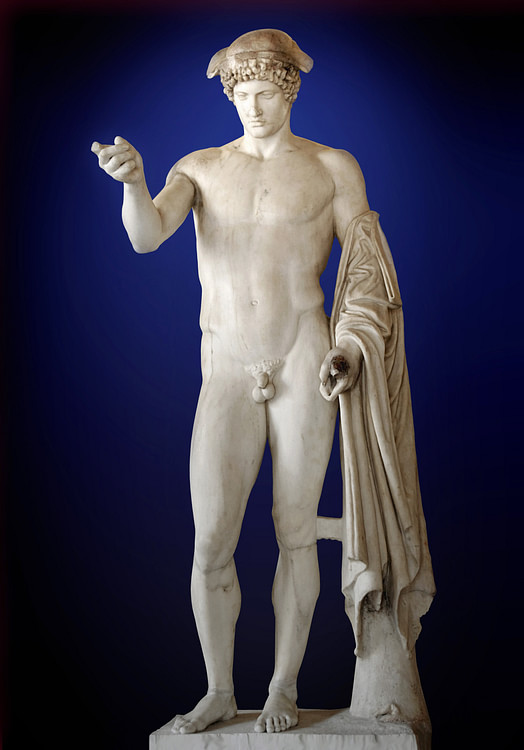
Hermes ( Roman name: Mercury ) was the ancient Greek god of trade, wealth, luck, fertility, animal husbandry, sleep, language, thieves, and travel. One of the cleverest and most mischievous of the Olympian gods, he was also their herald and messenger.
With origins as an Arcadian fertility god, the ancient Greeks believed he was the son of Zeus and Maia (daughter of the TitanAtlas ). In mythology, Hermes was also the father of the pastoral god Pan and Eudoros (with Polymele), one of the leaders of the Myrmidons.
Noted for his impish character and constant search for amusement, Hermes was one of the more colourful gods in Greek mythology. While still a baby he stole his half-brother Apollo ’s sacred herd of cattle, cleverly reversing their hooves to make it difficult to follow their tracks. Hermes therefore became associated with thieves and he kept the stolen herd in return for giving Apollo his lyre.
NOTED FOR HIS IMPISH CHARACTER AND CONSTANT SEARCH FOR AMUSEMENT, HERMES WAS ONE OF THE MORE COLOURFUL GODS IN GREEK MYTHOLOGY.
As messenger and herald, Hermes is involved in many mythological episodes. Perhaps most celebrated was his killing of the many-eyed (some accounts say 100-eyed) monster Argos on the orders of Zeus in order to free Io. Hermes also freed Aresfrom his year-long imprisonment in a cauldron by the twin Giants Otus and Ephialtes. One of his most famous regular roles was as a leader of souls to the river Styx in the underworld, where the boatman Charon would take them to Hades.
Hermes was also known as something of a trickster, stealing at one time or another Poseidon ’s trident, Artemis ' arrows, and Aphrodite ’s girdle. He was also credited with inventing fire, dice (and so was worshipped by gamblers in his capacity as god of luck and wealth), musical instruments, in particular, the lyre (made from a tortoise shell), and the alphabet. Famous for his diplomatic skills, he was also regarded as the patron of languages and rhetoric. Travellers regarded him as their patron, and stone pillars ( hermae ) with a phallus symbol were often to be seen set up along road sides. In addition, Hermes was regarded as patron of the home and people often built small marble stelai in front of their doors in his honour.
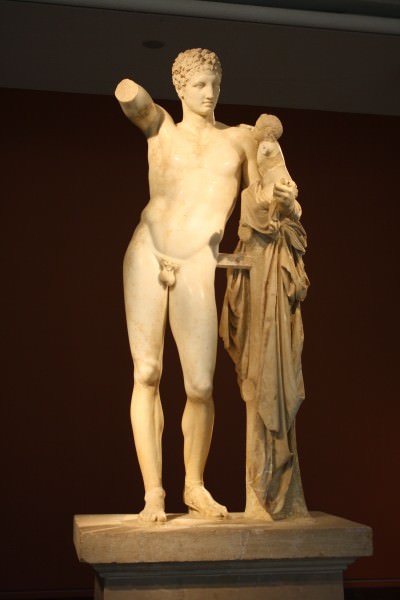
Hermes
Hermes figures in the Trojan War as told by Homer in the Iliad. Although in one lengthy passage he acts as counsellor and guide to the Trojan King Priam in his attempt to reclaim the body of his fallen son Hektor, Hermes actually supports the Achaeans in the Trojan War. The god is most often described by Homer as 'Hermes the guide, slayer of Argos' and 'Hermes the kindly'. Hermes gives particular help to Odysseus, especially on his long return voyage to Ithaca (as told in Homer's Odyssey ), for example, giving him an antidote to the spells of Circe. Another hero helped by the god was Perseus, Hermes giving him an unbreakable sword or sickle ( harpe ) of adamantine and guiding him to the three Graeae who would reveal the location of Medusa.
In ancient Greek Archaic and Classical art, Hermes is depicted holding the kerykeion or staff (signifying his role as a herald, the stick is either cleft or with an open figure of 8 at the top), wearing winged sandals (symbolic of his role as a messenger), a long tunic, sometimes also a winged cap ( petasos ), and occasionally with a lyre. Perhaps the most celebrated depiction in art of Hermes is the magnificent statue by Praxiteles (c. 330 BCE) which once stood in the temple of Hera at Olympia and now resides in the archaeological museum of the site.
LICENSE:
Article based on information obtained from these sources:with permission from the Website Ancient History Encyclopedia
Content is available under License Creative Commons: Attribution-NonCommercial-ShareAlike 3.0 Unported. CC-BY-NC-SA License